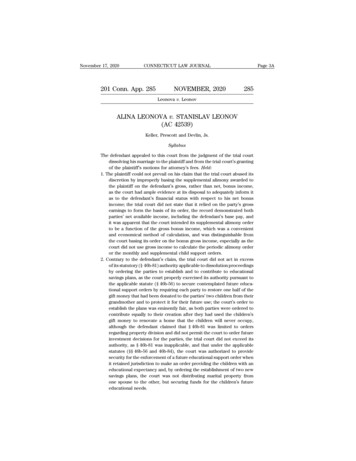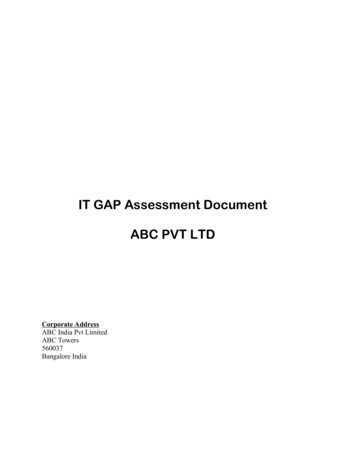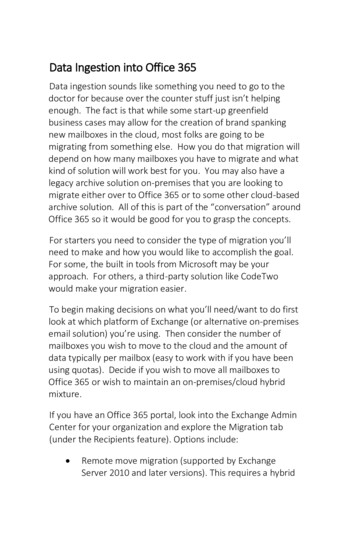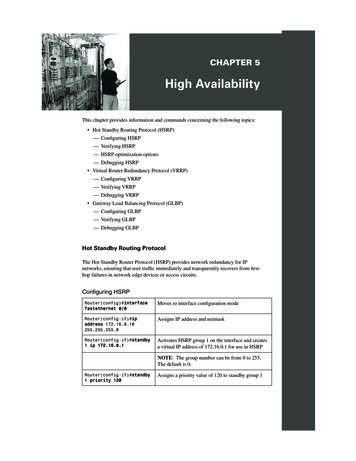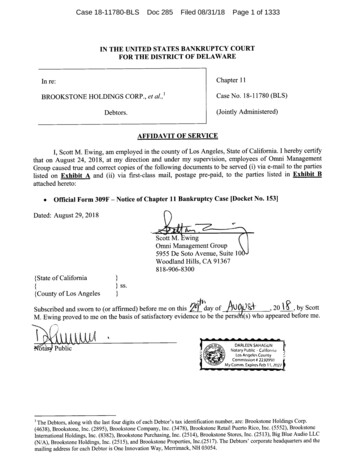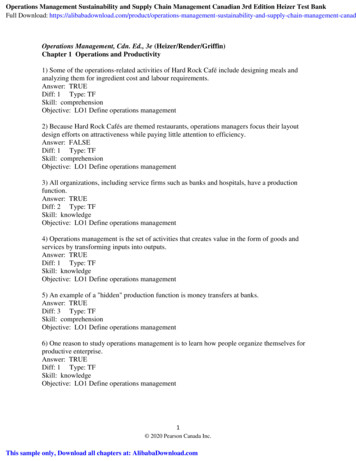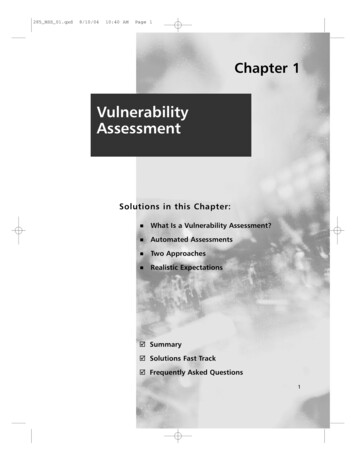
Transcription
285 NSS 01.qxd8/10/0410:40 AMPage 1Chapter 1VulnerabilityAssessmentSolutions in this Chapter: What Is a Vulnerability Assessment? Automated Assessments Two Approaches Realistic Expectations Summary Solutions Fast Track Frequently Asked Questions1
285 NSS 01.qxd28/10/0410:40 AMPage 2Chapter 1 Vulnerability AssessmentIntroductionIn the war zone that is the modern Internet, manually reviewing each networkedsystem for security flaws is no longer feasible. Operating systems, applications,and network protocols have grown so complex over the last decade that it takes adedicated security administrator to keep even a relatively small network shieldedfrom attack.Each technical advance brings wave after wave of security holes. A new protocol might result in dozens of actual implementations, each of which couldcontain exploitable programming errors. Logic errors, vendor-installed backdoors, and default configurations plague everything from modern operating systems to the simplest print server.Yesterday’s viruses seem positively tamecompared to the highly optimized Internet worms that continuously assaultevery system attached to the global Internet.To combat these attacks, a network administrator needs the appropriate toolsand knowledge to identify vulnerable systems and resolve their security problemsbefore they can be exploited. One of the most powerful tools available today is thevulnerability assessment, and this chapter describes what it is, what it can provideyou, and why you should be performing them as often as possible. Following this isan analysis of the different types of solutions available, the advantages of each, andthe actual steps used by most tools during the assessment process.The next sectiondescribes two distinct approaches used by the current generation of assessmenttools and how choosing the right tool can make a significant impact on the security of your network. Finally, the chapter closes with the issues and limitations thatyou can expect when using any of the available assessment tools.What Is a Vulnerability Assessment?To explain vulnerability assessments, we first need to define what a vulnerabilityis. For the purposes of this book, vulnerability refers to any programming error ormisconfiguration that could allow an intruder to gain unauthorized access.Thisincludes anything from a weak password on a router to an unpatched programming flaw in an exposed network service. Vulnerabilities are no longer just therealm of system crackers and security consultants; they have become the enablingfactor behind most network worms, spyware applications, and e-mail viruses.Spammers are increasingly relying on software vulnerabilities to hide theirtracks; the open mail relays of the 1990s have been replaced by compromised“zombie” proxies of today, created through the mass exploitation of commonwww.syngress.com
285 NSS 01.qxd8/10/0410:40 AMPage 3Vulnerability Assessment Chapter 1vulnerabilities. A question often asked is, “Why would someone target mysystem?”The answer is that most exploited systems were not targeted; they weresimply one more address in a network range being scanned by an attacker.Theywere targets of opportunity, not choice. Spammers do not care whether a systembelongs to an international bank or your grandmother Edna; as long as they caninstall their relay software, it makes no difference to them.Vulnerability assessments are simply the process of locating and reporting vulnerabilities.They provide you with a way to detect and resolve security problemsbefore someone or something can exploit them. One of the most common usesfor vulnerability assessments is their capability to validate security measures. Ifyou recently installed a new intrusion detection system (IDS), a vulnerabilityassessment allows you to determine how well that solution works. If the assessment completes and your IDS didn’t fire off a single alert, it might be time tohave a chat with the vendor.The actual process for vulnerability identification varies widely between solutions; however, they all focus on a single output—the report.This report providesa snapshot of all the identified vulnerabilities on the network at a given time.Components of this report usually include a list detailing each identified vulnerability, where it was found, what the potential risk is, and how it can be resolved.Figure 1.1 shows a sample Nessus Security Scanner report for a network of onlyfive systems; the number of vulnerabilities is already over 100!Figure 1.1 Sample Nessus Reportwww.syngress.com3
285 NSS 01.qxd48/10/0410:40 AMPage 4Chapter 1 Vulnerability AssessmentWhy a Vulnerability Assessment?Vulnerability assessments have become a critical component of many organizations’security infrastructures; the ability to perform a networkwide security snapshotsupports a number of security vulnerability and administrative processes. When anew vulnerability is discovered, the network administrator can perform an assessment, discover which systems are vulnerable, and start the patch installation process.After the fixes are in place, another assessment can be run to verify that the vulnerabilities were actually resolved.This cycle of assess, patch, and re-assess has becomethe standard method for many organizations to manage their security issues.Many organizations have integrated vulnerability assessments into theirsystem rollout process. Before a new server is installed, it first must go through avulnerability assessment and pass with flying colors.This process is especiallyimportant for organizations that use a standard build image for each system; alltoo often, a new server can be imaged, configured, and installed without theadministrator remembering to install the latest system patches. Additionally, manyvulnerabilities can only be resolved through manual configuration changes; evenan automated patch installation might not be enough to secure a newly imagedsystem. It’s much easier to find these problems at build time when configurationchanges are simple and risk-free than when that system is deployed in the field.We strongly recommend performing a vulnerability assessment against any newsystem before deploying it.While many security solutions complicate system administration, vulnerabilityassessments can actually assist an administrator. Although the primary purpose of anassessment is to detect vulnerabilities, the assessment report can also be used as aninventory of the systems on the network and the services they expose. Since enumerating hosts and services is the first part of any vulnerability assessment, regularassessments can give you a current and very useful understanding of the servicesoffered on your network. Assessments assist in crises: when a new worm is released,assessment reports are often used to generate task lists for the system administrationstaff, allowing them to prevent a worm outbreak before it reaches critical mass.Asset classification is one of the most common nonsecurity uses for vulnerability assessment tools. Knowing how many and what types of printers are in usewill help resource planning. Determining how many Windows 95 systems stillneed to be upgraded can be as easy as looking at your latest report.The ability toglance quickly at a document and determine what network resources might beovertaxed or underutilized can be invaluable to topology planning.www.syngress.com
285 NSS 01.qxd8/10/0410:40 AMPage 5Vulnerability Assessment Chapter 1Assessment tools are also capable of detecting corporate policy violations; manytools will report peer-to-peer services, shared directories full of illegally-sharedcopyrighted materials, and unauthorized remote access tools. If a long-time systemadministrator leaves the company, an assessment tool can be used to detect that abackdoor was left in the firewall. If bandwidth use suddenly spikes, a vulnerabilityassessment can be used to locate workstations that have installed file-sharing software.One of the most important uses for vulnerability assessment data is event correlation; if an intrusion does occur, a recent assessment report allows the securityadministrator to determine how it occurred, and what other assets might have beencompromised. If the intruder gained access to a network consisting of unpatchedWeb servers, it is safe to assume that he gained access to those systems as well.Notes from the Underground Intrusion Detection SystemsThe difference between vulnerability assessments and an IDS is not alwaysimmediately clear. To understand the differences between these complimentary security systems, you will also need to understand how an IDSworks. When people speak of IDSs, they are often referring to what is morespecifically called a network intrusion detection system (NIDS). A NIDS’ roleis to monitor all network traffic, pick out malicious attacks from the normaldata, and send out alerts when an attack is detected. This type of defenseis known as a reactive security measure as it can only provide you withinformation after an attack has occurred. In contrast, a vulnerability assessment can provide you with the data about a vulnerability before it is usedto compromise a system, allowing you to fix the problem and prevent theintrusion. For this reason, vulnerability assessments are considered a proactive security measure.Assessment TypesThe term vulnerability assessment is used to refer to many different types and levelsof service. A host assessment normally refers to a security analysis against a singlewww.syngress.com5
285 NSS 01.qxd68/10/0410:40 AMPage 6Chapter 1 Vulnerability Assessmentsystem, from that system, often using specialized tools and an administrative useraccount. In contrast, a network assessment is used to test an entire network ofsystems at once.Host AssessmentsHost assessment tools were one of the first proactive security measures availableto system administrators and are still in use today.These tools require that theassessment software be installed on each system you want to assess.This softwarecan either be run stand-alone or be linked to a central system on the network. Ahost assessment looks for system-level vulnerabilities such as insecure file permissions, missing software patches, noncompliant security policies, and outrightbackdoors and Trojan horse installations.The depth of the testing performed by host assessment tools makes it thepreferred method of monitoring the security of critical systems.The downside ofhost assessments is that they require a set of specialized tools for the operatingsystem and software packages being used, in addition to administrative access toeach system that should be tested. Combined with the substantial time investment required to perform the testing and the limited scalability, host assessmentsare often reserved for a few critical systems.The number of available and up-to-date host assessment solutions has beendecreasing over the last few years.Tools like COPS and Tiger that were used religiously by system administrators just a few years ago have now fallen so farbehind as to be nearly useless. Many of the stand-alone tools have been replacedby agent-based systems that use a centralized reporting and management system.This transition has been fueled by a demand for scalable systems that can bedeployed across larger server farms with a minimum of administrative effort. Atthe time of this publication the only stand-alone host assessment tools used withany frequency are those targeting nontechnical home users and part-time administrators for small business systems.Although stand-alone tools have started to decline, the number of “enterprisesecurity management” systems that include a host assessment component is stillincreasing dramatically.The dual requirements of scalability and ease of deployment have resulted in host assessments becoming a component of larger management systems. A number of established software companies offer commercialproducts in this space, including, but not limited to, Internet Security System’sSystem Scanner, Computer Associates eTrust Access Control product line, andBindView’s bvControl software.www.syngress.com
285 NSS 01.qxd8/10/0410:40 AMPage 7Vulnerability Assessment Chapter 1Network AssessmentsNetwork assessments have been around almost as long as host assessments,starting with the Security Administrator Tool for Analyzing Networks (SATAN),released by Dan Farmer and Wietse Venema in 1995. SATAN provided a newperspective to administrators who were used to host assessment and hardeningtools. Instead of analyzing the local system for problems, it allowed you to lookfor common problems on any system connected to the network.This opened thegates for a still-expanding market of both open-source and commercial networkbased assessment systems.A network vulnerability assessment locates all live systems on a network,determines what network services are in use, and then analyzes those services forpotential vulnerabilities. Unlike the host assessment solutions, this process doesnot require any configuration changes on the systems being assessed. Networkassessments can be both scalable and efficient in terms of administrative requirements and are the only feasible method of gauging the security of large, complexnetworks of heterogeneous systems.Although network assessments are very effective for identifying vulnerabilities,they do suffer from certain limitations.These include: not being able to detect certain types of backdoors, complications with firewalls, and the inability to test forcertain vulnerabilities due to the testing process itself being dangerous. Networkassessments can disrupt normal operations, interfere with many devices (especiallyprinters), use large amounts of bandwidth, and create fill-up disks with log files onthe systems being assessed. Additionally, many vulnerabilities are exploitable by anauthorized but unprivileged user account and cannot be identified through a network assessment.Automated AssessmentsThe first experience that many people have with vulnerability assessments is usinga security consulting firm to provide a network audit.This type of audit is normally comprised of both manual and automated components; the auditors will useautomated tools for much of the initial legwork and follow it up with manualsystem inspection. While this process can provide thorough results, it is often muchmore expensive than simply using an automated assessment tool to perform theprocess in-house.The need for automated assessment tools has resulted in a number of advancedsolutions being developed.These solutions range from simple graphical user interwww.syngress.com7
285 NSS 01.qxd88/10/0410:40 AMPage 8Chapter 1 Vulnerability Assessmentface (GUI) software products to stand-alone appliances that are capable of beinglinked into massive distributed assessment architectures. Due to the overwhelmingnumber of vulnerability tests needed to build even a simple tool, the commercialmarket is easily divided between a few well-funded independent products and literally hundreds of solutions built on the open-source Nessus Security Scanner.Theseautomated assessment tools can be further broken into two types of products: thosethat are actually obtained, through either purchase or download, and those that areprovided through a subscription service.Stand-Alone vs. SubscriptionThe stand-alone category of products includes most open-source projects andabout half of the serious commercial contenders. Some examples include theNessus Security Scanner, eEye’s Retina,Tenable Security’s Lightning Proxy, andMicrosoft’s Security Baseline Scanner.These products are either provided as asoftware package that is installed on a workstation, or a hardware appliance thatyou simply plug in and access over the network.The subscription service solutions take a slightly different approach; insteadof requiring the user to perform the actual installation and deployment, thevendor handles the basic configuration and simply provides a Web interface tothe client.This is primarily used to offer assessments for Internet-facing assets(external assessments), but can also be combined with an appliance to providedassessments for an organization’s internal network. Examples of products that areprovided as a subscription service include Qualys’ QualysGuard, BeyondSecurity’sAutomated Scan, and Digital Defense’s Frontline product.The advantages of using a stand-alone product are obvious: all of your datastays in-house, and you decide exactly when, where, and how the product isused. One disadvantage, however, is that these products require the user to perform an update before every use to avoid an out-of-date vulnerability check set,potentially missing recent vulnerabilities.The advantages of a subscription servicemodel are twofold: the updates are handled for you, and since the external assessment originates from the vendor’s network, you are provided with a real-worldview of how your network looks from the Internet.The disadvantages to a subscription solution are the lack of control you haveover the configuration of the device, and the potential storage of vulnerabilitydata on the vendor’s systems. Some hybrid subscription service solutions haveemerged that resolve both of these issues through leased appliances in conjunction with user-provided storage media for the assessment data. One product thatwww.syngress.com
285 NSS 01.qxd8/10/0410:40 AMPage 9Vulnerability Assessment Chapter 1implements this approach is nCircles’ IP360 system, which uses multiple dedicated appliances that store all sensitive data on a removable flash storage device.The Assessment ProcessRegardless of what automated assessment solution is used, it will more than likelyfollow the same general process. Each assessment begins with the user specifyingwhat address or address ranges should be tested.This is often implemented aseither a drop-down list of predefined ranges or a simple text widget where thenetwork address and mask can be entered. Once the addresses are specified, theinterface will often present the user with a set of configuration options for theassessment; this could include the port ranges to scan, the bandwidth settings touse, or any product-specific features. After all of this information is entered, theactual assessment phase starts. Figure 1.2 shows the assessment configurationscreen for the Nessus Security Scanner.Figure 1.2 Nessus Scan OptionsDetecting Live SystemsThe first stage of a network vulnerability assessment determines which InternetProtocol (IP) addresses specified in the target range actually map to online andaccessible systems. For each address specified by the user, one or more probes arewww.syngress.com9
285 NSS 01.qxd108/10/0410:40 AMPage 10Chapter 1 Vulnerability Assessmentsent to elicit a response. If a response is received, the system will place thataddress in a list of valid hosts. In the case of heavily firewalled networks, mostproducts have an option to force scan all addresses, regardless of whether aresponse is received during this stage.These types of probes sent during this stage differ wildly between assessmenttools; although almost all of them use Internet Control Message Protocol(ICMP) “ping” requests, the techniques beyond this are rarely similar betweentwo products.The Nessus Security Scanner has the capability to use a series ofTCP connection requests to a set of common ports to identify systems thatmight be blocking ICMP messages.This allows the scanner to identify systemsbehind firewalls or those specifically configured to ignore ICMP traffic. After aconnection request is sent, any response received from that system will cause it tobe added to the list of tested hosts. Many commercial tools include the capabilityto probe specific User Datagram Protocol (UDP) services in addition to thestandard ICMP and TCP tests.This technique is useful for detecting systems thatonly
System Scanner,Computer Associates eTrust Access Control product line,and BindView’s bvControl
